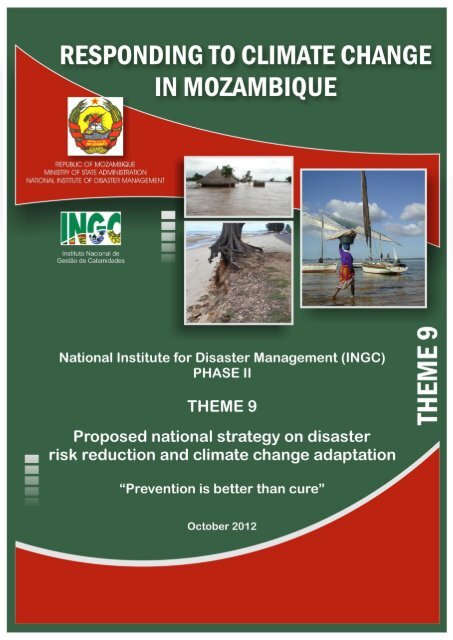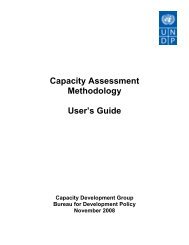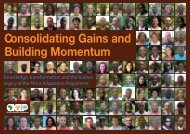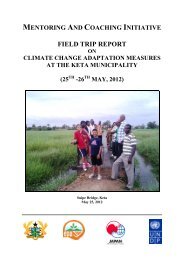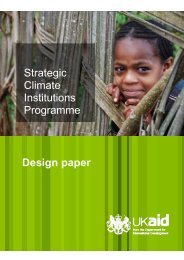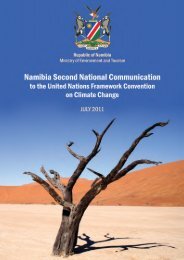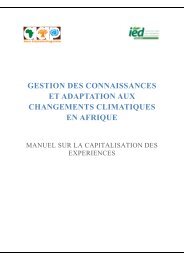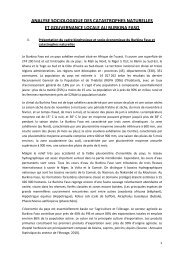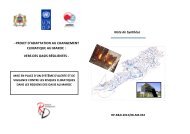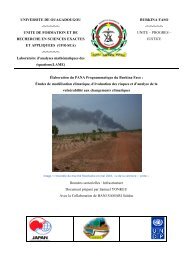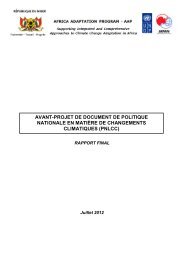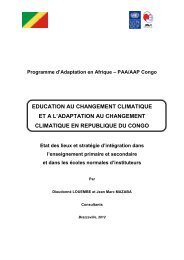Theme 9 Strategy ENG.pdf - Africa Adaptation Programme
Theme 9 Strategy ENG.pdf - Africa Adaptation Programme
Theme 9 Strategy ENG.pdf - Africa Adaptation Programme
- No tags were found...
You also want an ePaper? Increase the reach of your titles
YUMPU automatically turns print PDFs into web optimized ePapers that Google loves.
I. RATIONALE AND POLITICAL GUIDELINES ___________________________ 4I.I IMPACT OF DISASTERS AND CLIMATE CHANGE ON PEOPLE AND GOODS 4I.IIOUTCOMES OF THE MOST RECENT STUDIES ON THE CLIMATE CHANGE IMPACTSIN THE COUNTRY 5I.III STRATEGY SCOPE AND REACH 6I.IV LINKAGE WITH NATIONAL PRIORITIES 6I.V LEADERSHIP ROLE 7I.VI BUILD ON WHAT ALREADY EXISTS 7I.VII SCIENTIFIC KNOWLEDGE GENERATION 7I.VIII FUNDING AND SUSTAINABILITY 8I.IX BUILDING RESILIENCE WITH THE PRIVATE SECTOR 8I.X PARTICIPATORY AND INCLUSIVE DESIGN AND IMPLEMENTATION 9I.XI MONITORING AND EVALUATION 9II. NATIONAL VISION _____________________________________________ 9III. PILLARS ____________________________________________________ 9IV. ACTION PLAN AND BUDGET ____________________________________ 14IV.I ACTION PLAN 14Annex 1- MATRIX OF ACTIONS AND DEADLINES OF ENARC FOR5 YEARS (2012-2016) 15October 2012, p 3
I. Rationale andPolitical GuidelinesI.IIMPACT OF DISASTERS ANDCLIMATE CHANGE ONPEOPLE AND GOODSThe Government of Mozambique, conscious ofthe increased vulnerability of the country tonatural disaster risks, has been continuouslyendeavouring to mobilise citizens andcommunities and in the reinforcement andconsolidation of multi sectorial capacity inorder to face the challenges imposed by naturaldisasters. The action of the Government ofMozambique has so far contemplated thedevelopment of a specific institutionalframework aimed at reducing disaster risksnationwide. The framework covers the localand national levels and includes the LocalCommittees of Natural Disasters RiskManagement at the level of rural and urbancommunities, the Multi Purpose ResourceCentres, the District and Provincial EmergencyOperations Centres, the National EmergencyOperations Centre, (CENOE), the TechnicalCouncils for Disaster Management and theDisaster Management Coordinating Council(CCGC).However, the national and international realityshows that natural disasters and their impacton the lives and well-being of the communitiesand on the socioeconomic infrastructure, tendto be aggravated by a very concerningframework of Climate Change.Bearing in mind the climate change impacts ondisaster risk, there is an urgent need toreinforce the mechanisms of preparedness ofthe country, of its citizens and of thecommunities in order to effectively facedisaster risks at a greater scale.In this context, it is pertinent to adopt astrategy and its respective action plan aimed atdefining the guidelines, actions and resourcesthat are necessary to protecting the vitalinfrastructure for the socioeconomicdevelopment of the country, and to capacitatethe citizens and the communities to reducetheir level of vulnerability to increasing disastereffects caused by the influence of climatechange which require coordinatedinterventions in different dimensions and atdifferent levels. The experience of the lastdecades, such as the floods witnessed in theyear of 2000, the impacts of Favio tropicalcyclone in 2007 and the subsequent eventsshow that there is an urgent need to findimmediate solutions for minimizing thesocioeconomic impacts through the integrationof disaster risk mitigation measures in thedevelopment plans.In this sense, the present strategy proposalmust be regarded as part of the otherapproaches and guiding tools adopted by theGovernment in the context of climate changes.October 2012, p 4
I.II OUTCOMES OF THE MOSTRECENT STUDIES ON THECLIMATE CHANGE IMPACTSIN THE COUNTRYAlthough the outcomes of the studies onclimate change impacts available at global,regional and national levels, cannot not beconsidered as conclusive, considering that thistype of exercise constitute a process that canbe improved and updated with theadvancement of knowledge on the current andfuture behaviour of the nature, the studiesPhase I and II of the INGC Project serve as ascientific base for decision making on the issueof reducing vulnerability in the face of climatechange risks.Indeed, international experience shows that nocountry has so far been able to foresee thefuture with precision in terms of occurrence ofnatural disasters and their impact on theenvironment, on the people, infrastructure andon the economy. What is attempted today is toachieve a margin of scientific reliability which ispresent in the studies conducted by INGC,outcomes of which show that climate changeeffects are already visible on a daily basis andtheir worsening in the coming years isuncontested.Facts and projections of Phase I and II of the theINGC Project:a) acceleratedreduction of agricultural yieldlevels by up to 20% for the main cropswhich constitute the the basis of foodsecurity the condition for improving percapita income of Mozambicanhouseholds;b) Reduction of areas available foragriculture practice in the green or lowerzones;c) Irregular rains in terms of beginning andend of the rainy season, amount of rainfalland duration of the rainy season ,disfiguring the notions of “officialbeginning of the rain season” and the“real beginning” of the agriculturalcampaign, which could result in potentialreductions of agricultural yield in someregions by up to 25%;d) Prevailing of a situation of extraordinaryfloods in identifiable locations of thecountry, which can be referred to as risk“locations” or “zones”;e) Existence of zones which can be identifiedas being ‘of added potential risk’ due toother emerging adverse naturalphenomena such as coastal erosion,intrusion of salt water, desertification,cyclones and other strong events;f) Definition of six high-risk, high-impactzones which extend to a population ofabout 7 million Mozambicans, that is,more than 1/3 of the total population ofthe country. These zones were definedbased on several types of risks, namelycoastal fragility, population density,drought zones, flood prone zones, nonproductivezones or with decreasingagricultural income, amongst others;g) It is estimated that these six zonesrepresent a value at risk in the comingdecade in the order of 14 billion americandollars;h) Many of the main urban centres of theCountry, including Maputo, Beira andQuelimane, find themselves in a criticalsituation in terms of vulnerability (humanlives, properties, social infrastructure, etc.)due to cimate change effects. The forestof the country is also in a critical situation,deforestation of which is caused both byuncontrolled bush fire and by tree-cuttingat frightful proportions without concreteplans for replanting. Consequently, thedeforestation through the abovementioned actions should be part of theset of national disasters anddeservesspecial treatment as is the casewith the other catastrophes that are, inOctober 2012, p 5
general, identified by Government policiesand action programmes in the scope ofdisaster management.I.III STRATEGY SCOPE ANDREACHClimate change brings along fourcorresponding categories of challenges andactions: (a) protection of the environmentwhich nowadays includes the so-called lowlevel carbon development, (b) forecasting ofphenomena and impacts arising from climatechange, (c) disaster management and (d)adaptation.Despite the existence of an interconnectionbetween these four categories of action, thepresent strategy focuses essentially on thethree last categories: forecasting of phenomenaand impacts arising from climate change,disaster management and adaptation, whichare regarded as being more linked with theissue of vulnerability reduction.Experience shows that, in general, at thecentral level, it is possible to distinguishbetween the areas of implementation andaccountability, but at provincial and local levelsthe differentiation is not justifiable, particularlyin relation with the objectives of rationalizingState financial resources..In this sense, the present draft strategy iscentred on the necessary actions aimed atreducing the risk of vulnerability of people,communities and infrastructure, including adifferent approach in agricultural production,urbanization and construction, tourist activities,protection of persons and goods,humanitarianassistance, in the face of of natural disastersand protection of risk zones.The National <strong>Strategy</strong> for Disaster RiskReduction and Climate Change <strong>Adaptation</strong>(ENARC) will have to be in compliance withpresent and future governance measures, toolsand legislation, including those to be adoptedby the Government in general for theprotection of the environment and for thesustainable use of land and other naturalresources in view of climate change.I.IV LINKAGE WITH NATIONALPRIORITIESClimate change may significantly affect the livesof people, community goods and the economyof large areas of the country. However,resource difficulties may not allow the rightamounts of attention and prioritization to begiven to them.A way of solving or attenuating thiscontradiction is to associate this new theme tothe efforts of poverty reduction: on the onehand, the poorest layers of the population arethe most affected; on the other hand, thepoorest people, due to lack of alternativemeans, place themselves in the mostvulnerable situations. In addition, the lack ofalternatives makes these people resort tosubsistence means which are more destructiveto nature.The political economy of the climate changestrategy aims at reinforcing, within the strategyof fight against hunger, those actions thatsimultaneously reduce poverty and protectnature, such as housing in risk zones, low costenergy alternatives, forms of local organization,conservation agriculture and expansion of thehousehold income base.On the other hand, one should bear in mindthat in high risk zones such as those along thecoast, there is important, on-going investmentwhile at the same time, there is a remarkableflow of people to those zones. Given theprecariousness of these zones, one of themeasures to be explored could be theintroduction of an additional fee for landOctober 2012, p 6
ownership and use in these zones, theidentification and classification of which mustbe according to criteria to be adopted in thelegislation on land and special planning.This strategy proposal does not lose sight of thefact that climate change, despite their negativeeffects, also offer opportunitiesfor innovationin disaster risk management, infrastructuredevelopment, prosperity and more safety ofthe communities, as well as economic stabilityof the country.I.V LEADERSHIP ROLEThe awareness of the leaders on theseriousness of climate change impact onpeople, infrastructure and the economy isincreasing at different political andadministrative levels in the country. There isalso an attitude of general receptivity fordisaster prevention. These factors form afundamental reason for the drafting andimplementation of the present strategy.However, there is still a need to strengthenleadership at the level of implementation ofadaptation, including more raising ofawarenessand accountability for all leaders, each withinthis or her sector and level of implementation.Taking into consideration that climate relatedtopics must be known nationwide, it will benecessary to prioritise the efficientdissemination of this knowledge amongstdecision-makers.I.VI BUILD ON WHAT ALREADYEXISTSIn Mozambique there is a consolidated andramified institutional implementation ofdisaster management at various levels of thecountry ranging from practical experiences,local initiatives, early warning systems,preparation of stocks, droughts forecastsandsimulations, amongst others. There is also anetwork of structures to deal with naturaldisasters.In this case, adaptation is not only a process oftechniques and technologies, but also a socialand voluntary approach associated with real lifeexperience and based on values and standardsof individuals and communities.The design and implementation of the National<strong>Strategy</strong> for Disaster Risk Reduction andClimate Change <strong>Adaptation</strong> are based onbuilding on what already exists: from what isknown on what has already been built in termsof thinking, policies, legislation, practices andnational structures, as well as internationalpartnership networking.It is, therefore, necessary to adjust andreinforce the institutional framework andcapacity installed at INGC, as a response centreof the country, to respond to the newchallenges of adaptation to climate change forthe sake of reducing the vulnerability of thepeople and their assets..The sensitivity and goodwill of the internationalcommunity towards disaster risk reduction andreduction of vulnerability arising from climatechange, are fundamental for understanding thecomplexity of the phenomena which crossborders and continents.I.VII SCIENTIFIC KNOWLEDGEGENERATIONClimate change is a relatively new topic and thelevel of scientific and technological advance forprojecting the occurrence and the impact ofthese phenomena worldwide, is far fromattending the real needs.On the other hand, the current scientificknowhow and technological development allowto more easily forecast the occurrence andOctober 2012, p 7
impacts of natural phenomena for large regionsor globally, than nationally or locally.,This makes essential the existence of a nationalcritical mass, including the establishment of aCentre of Knowledge on Climate Change withthe necessary representation throughout thecountry. The knowledge generated by thiscentre will have to be progressively transferredand owned by the higher education institutions.Whichever way and particularly when scientificdata is not sufficient or is not definite, it will benecessary to prioritise prevention as the mainline of action for saving resources and forencouraging development.climate change and disaster prevention meansanticipating inevitable expenses, savingcommunities from suffering and avoidingpossible damage to socioeconomicinfrastructure, all of which can prevent futureregrets.The strategy takes into consideration theopportunity offered by international funding forclimate change adaptation and the need for thecountry to be equipped with a credible andflexible mechanism for reception, channellingand control of the use of the funds referred to,as well as having an internal capacity forabsorbing the funds, including theestablishment of a Common Fund for DisasterRisk Reduction and Vulnerability Reduction.I.IX BUILDING RESILIENCE WITHTHE PRIVATE SECTORThe private sector, in conjunction with thepublic sector, including the informal economicagents, is an important contributor to thesustainability and stability of the country. Butevery time a natural disaster hits the country,they are the most affected in terms of loss ofproperty and other assets.I.VIII FUNDING ANDSUSTAINABILITYIn periods of national and internationaleconomic contention, the concern must be toincorporatethe strategy recommendations intosectoral and local plans and budgets.Therefore, the strategy must consist of apermanent awareness raising component forthose involved in budgetary decision-making,taking into consideration that investing inOn the other hand, at these occasions, theprivate sector has been contributing with itsmeans and resources in the actions undertakenby the Government and other entities to grantassistance to the affected households or in therecovery of social infrastructure.In this context, the private sector must beincluded in the design and implementation ofadaptation measures at the central level notjust as atarget of necessary support, but also asa potential source of the resources that arenecessary, including in contributing to theCommon Fund for Disaster Risk Reduction andVulnerability Reduction; in theinstitutionalization of a Unique Point of Contactfor the private sector in the context ofOctober 2012, p 8
adaptation measures; and in theencouragement of public-private partnershipsfor co-funding the adaptation measuresregarded as more costly.I.X PARTICIPATORY ANDINCLUSIVE DESIGN ANDIMPLEMENTATIONThe design of the National <strong>Strategy</strong> for DisasterRisk Reduction and Climate Change <strong>Adaptation</strong>emerged fromthe continuity of the Phases Iand II of the work that INGC (Instituto Nacionalde Gestão das Calamidades) has beenundertaking and which consists of conducting aseries of studies and surveys aimed atdetermining the potential Impacts of andSolutions for Climate Change in Mozambique ,with emphasis on disaster risk management, asprojected for the periods of 2030-40 and 2060.The proposed National <strong>Strategy</strong> was designedbased on the outcomes of Phases I and II of theproject conducted by INGC, followed by aconsultation process and hearing of the mainactors and target groups at different verticallevels (central, provincial and district) andhorizontal levels (municipalities, civil societyorganizations, private sector, cooperationpartners, local communities, etc.).The implementation of the strategy will need toundergo the same process of participation andinclusion of all Mozambicans.I.XI MONITORING ANDEVALUATIONThe <strong>Strategy</strong> shouldl be subject to annualevaluation and INGC will annually register andinform the Government about the level ofachievement of foreseen objectives and goals,as well as propose the necessary measures foradjustment or updating.In a term of one year, INGC will design andpropose for approval to the Government amonitoring and evaluation plan of the <strong>Strategy</strong>,as well its actualization, to be preceeded by anexhaustive independent assessment.II. National VisionThe national vision of Mozambique relating todisaster risks arising from climate change overthe next 25 years is:“A country with a high culture of prevention andpreparedness reduces the loss of human livesand properties and minimizes the risk ofexposure to vulnerability”.III. PILLARSPillar I: Preparedness andcapacitating building for peopleand communities1. Objectives1.1. Within 20 years, reduce to the minimum(15 -20%) the level of vulnerability of theurban and rural communities mostexposed to risk;1.2. Capacitate people and communities(rural and urban) on how to deal withdisaster risk (adaptation) in view ofclimate change;1.3. Ensure a coordinated action of thedifferent community committeesestablished under different legislationson land and other natural resources,with the aim of integrating them in thewider implementation of adaptation toclimate change;1.4. Systematize knowledge on the successesand challenges of risk management atthe community level, by means of aOctober 2012, p 9
systematic collection of local needs andpractices;1.5. Ensure water availability forconsumption and irrigation and industry,and reduce saline intrusion in potablewater of human settlements;1.6. Minimize the adverse effects of the risein sea level and inland water levels;1.7. Capacitate the big cities to deal withclimate change, especially in the area ofcoastal protection.2. Actions2.1. Promote a set of concrete projects infavour of disaster risk reduction andadaptation spread out over the differentprovinces, the number and quality(relevance) of which will increase as thecountry attains the capacity to designand implement this type of interventions(a total of 50 projects a year, at least 5 ineach province, increasing this number todouble in subsequent years). Theprojects must include those aimed at“avoiding mistakes” that increasehuman, infrastructural and economiclosses;2.2. Disseminate specific information andmessages on adaptation measures topeople and communities located in highrisk zones and regarded as priority forINGC intervention;2.3. Promote and facilitate, in coordinationwith the sector supervising thepromotion of rural development , theexistence and operation at thecommunity level of a Conciliation Forumof the different local committeesinvolved in the planning of naturalresources, including the approval of therespective basic regulation by 2014;2.4. Capacitate and equip the alreadyexisting Local Committees for NaturalDisaster Risk Management, includingapproval of their basic internalregulation, by 2012;2.5. Establish Local Committees for NaturalDisaster Risk Management in allcommunities (rural and urban) located inrisk zones that do not yet have suchmechanisms, by 2013;2.6. Compile and disseminate through apublication entitled <strong>Adaptation</strong> Stories,successful experiences and challengesovercome;2.7. Prepare and implement, through thesectors of water, public works andirrigation, in coordination with the localgovernments, municipal authorities andlocal communities, within a 5-yearperiod, an action plan aimed atincreasing the national capacity forsuperficial and groundwater reserves,especially for vulnerable communities;2.8. Design and implement at least 5 coastalmanagement plans, in the big cities.Pillar II: Institutional capacitybuilding and coordination3. Objectives3.1. Equip de Country with a coherent andefficient regulatory and institutionalframework for implementing the actionsof response to climate change anddisaster risk management, including thefinancing dimension this represents;3.2. By 2015, the country shouldbe equippedwith the capacity to produce sciencebasedevidence for decision-making atthe political level and implementation ofconcrete adaptation measures inMozambique.3.3. Contribute to the national efforts aimedat increasing the capacity of the countryin managing water resources given theenormous demand, variability andgrowing risk of disasters arising fromclimate change;3.4. Reinforce national capacity in the area ofcivil protection, including the provisionOctober 2012, p 10
of a national civil protection team inview of a response at a larger scale;3.5. Equip the country with the capacity tomobilise resources existing at the levelof international climate change fundingmechanisms, including compliance withthe standards and respective rulesimposed in the internationalinstruments, by 2012.4. Actions4.1. Adapt and strengthen the institutionalframework and capacity of INGC as aninstitutional point of implementation ofresponse measures in relation to thenew challenge of risk reduction andvulnerability brought by climate changeadaptation;4.2. Update the Disaster ManagementMaster Plan by 2012;4.3. Support INAM (National Institute ofMeteorology) with necessary means formore efficient weather forecasting, thusallowing better adaptation to climatechange;4.4. Create units for disaster riskmanagement and climate changeadaptation in each ministry and otherpublic sectors;4.5. Design and / or update and implementat least 4 (2 laws and 2 regulations) legalinstruments on building codes forinfrastructure and settlements in areasof risk, including the possibility of amechanism of expropriation for publicpurposes;4.6. Establish at the Academy of Sciences ofMozambique and in partnership withINGC and the Ministries of Science andTechnology, Education and Coordinationof Environmental Affairs, a Centre ofKnowledge on the management ofdisaster risk resulting from climatechange;4.7. Strengthen the financial capacity of thepublic media in order to disseminateinformation on adaptation measures;4.8. Design and implement three projectswith the Technical Secretariat for FoodSecurity and Nutrition (SETSAN),including the necessary fundraising forcarrying out the activities;4.9. Conduct joint activities between INGCand IIAM (Mozambique AgrarianResearch Institute) for research anddissemination of techniques and cropsresistant/adaptable to climate change ;4.10. Design and implement joint projectswith the three Regional WaterAdministrations, including the necessaryfundraising ;4.11. In a joint action between INGC andEduardo Mondlane University, two fieldtrials must be designed andimplemented on the impact of groundlevel ozone on crop yield;4.12. Jointly with INGC, restructure andstrengthen the activity of civilprotection;4.13. By 2012, create the Fund for DisasterRisk Reduction and VulnerabilityReduction as a separate account thatreports directly to the Council ofMinisters;4.14. Design and promote the correspondingapproval by sectors responsible forconstruction, public works and landallocation, in coordination withcommunity leaders, local and municipalgovernment, of measures to discourageand prohibit construction and buildingin areas prone to flooding, erosion andcyclones, as well as in other precariousterrain;, including through theadjustment of the legal framework onland use, planning, land allocation,building, construction licensing andrecourse to the institute of publicinterest to revoke land rights and otherOctober 2012, p 11
properties existing on these lands.Deadline: Immediate;4.15. The relevant government sectors mustdesign and approve, in coordination withthe municipal authorities, the measuresaimed at introducing compound taxesfor land use and construction in high riskareas. Deadline: Immediate.6.4. Increase the number of projects fundedby the District Development Fund (FDD)which promotes initiatives of adaptationto climate change. Deadline: Immediate;6.5. Establish with the INGC a competitivefund to promote and fund initiatives onadaptation projects: starting with 15projects per year. Deadline: from 2013.Pillar III: Planning and budgetingfor adaptation5. Objectives5.1. Consider disaster risk and vulnerabilityinvoked by climate change as a crosscuttingissue requiring its inclusion in theformulation of national policies andother instruments of governance,including at the level of legalframeworks;5.2. Include the issue of adaptation toclimate change on the agenda ofdevelopment and poverty reduction,including the role of developmentpartners in financing the Poverty ReliefandReduction <strong>Programme</strong>;6. Actions6.1. Include the issue of disaster riskmanagement and climate changeadaptation in sectoral programmes,strategies and plans, as well as in otherinstruments of governance and incorresponding regulations andguidelines. Deadline: Immediate.6.2. Include climate change adaptationactivities in sectoral economic and socialplans and budgets, as well as in nationaleconomic and social plans. Deadline:immediate;6.3. Include the issue of climate changeadaptation in district developmentplans. Deadline: Immediate;Pillar IV: Communication andInformation7. Objectives7.1. Produce and disseminate knowledgeand information needed on climatechange vulnerability and its impacts onthe economic and social life of thecountry, communities and households inorder to enable informed decisionmakingat all levels of the governmentand at the level of households and localcommunities;7.2. Raise the level of national awarenessand that of individual citizens to allowfor a national mobilization in response toclimate change.October 2012, p 12
8. Actions8.1. Design and implement a nationalstrategy of communication on climatechange adaptation, as well as its actionplan. Deadline: immediate;8.2. Disseminate through various mediaStories of <strong>Adaptation</strong>, which narratesuccessful experiences and challengesovercome. Deadline: immediate;8.3. Form a team of 3-5 information officers(per district) to disseminate informationon disaster risk management andadaptation at the community level.Deadline: immediate;8.4. Promote and implement informationdissemination campaigns on adaptationmeasures, with priority given to areas ofhighest risk, using differentmethodologies. Deadline: immediate;8.5. Design and maintain an informationportal on climate change.Pillar V: Creating Resilience withthe Private Sector9. Objectives9.1. Promote the private sector participationin the implementation of adaptationmeasures, ensuring that investmentsgenerate sustainable and positiveadaptation benefits for the economyand society.10. Actions10.1. Design and Implementation, as from2013, at least 4 concrete programmeson adaptation to climate change,including through a Unique Point ofContact;10.2. Design and implement a <strong>Programme</strong>aiming to bring the private sector tocontribute to the financing of adaptationand risk reduction measures, withemphasis on companies in the miningand forestry industries. Deadline:immediate;10.3. Creation of a Unique Point of Contact(UPC), directly reporting to the Office ofthe Prime Minister, with the primaryresponsibility of coordinating theimplementation of all established privatesector programmes and with the specificresponsibilities of negotiating withinvestors and lenders, and dealing withinter-sectorial coordination. Deadline:Immediate;10.4. Establishment of a Cross-cutting Teamcapable of working in conjunction withthe different Government entities and incoordination with Specific Teams andwith the UPC. Deadline: by 2013;10.5. Implementation of a selection processof future projects to be implemented inthe wake of these four initialprogrammes, highlighting the projectswith sustainable adaptation benefitscoupled with financial returns. Deadline:by 2013;10.6. Hiring and training of specialized localresources in order to allow, in the nearfuture, a full autonomy in themanagement and design of newprogrammes / projects. Deadline: by2013;10.7. Development of procurement platformsthat facilitate and accelerate privateinvestments, notably communicationchannels, especially roads andtelecommunications. Deadline:immediate;10.8. Dissemination and Marketing of allinitiatives on sustainability as one of thenew development paradigms ofMozambique. Deadline: by 2013.October 2012, p 13
IV. ACTION PLAN ANDBUDGETIV.I ACTION PLANThe National <strong>Strategy</strong> for Disaster RiskReduction and Climate Change <strong>Adaptation</strong> isdrafted with a 25-year horizon and should beimplemented in phases. Each phase should last5 years, being reviewed and updated for thenext 5 years in succession.In terms of priorities identified in theimplementation of the strategy, the first to behighlighted is the adjustment andreinforcement of the institutional frameworkand capacity in INGC as the centre of thecountry’s response to the new challenge ofadaptation to climate change and disaster riskreduction, including the updating of its MasterPlan.The Matrix herewith presented in Annexdescribes in more detail the actions andtimelines of this strategy.The actions envisaged by this strategy will bethe subject of an Operational Plan thatidentifies specific and detailed activities andtheir costs, performance and impact indicators,as well as the timelines and implementationpartners.INGC is responsible for designing andpresenting the Operational Plan of the presentstrategy to the Government, through the organin charge, within 90 days.At the same level, the objective of equippingthe country with the capacity to financeinitiatives related to adaptation, specifically thecreation of the Fund for Disaster Risk Reductionand Vulnerability Reduction as an autonomousaccount, the value of which must set out theadaptation measures and initiatives.Still on the list of priorities, there is the need tostrengthen research capacity, best practicesand adaptation measures, as well as otheractivities, implementation of which has alreadystarted as part of current INGC activities,including the equipping of Municipal Plans withcoastal protection.Another challenge and priority to behighlighted is related to the fund raising for theimplementation of this strategy, which mustcount on the support from the developmentpartners and from the private sector.October 2012, p 14
Annex 1- MATRIX OF ACTIONS AND DEADLINES OF ENARC FOR 5 YEARS (2012-2016)OBJECTIVES ACTIONS DEADLINE STAKEHOLDERSBUDGET (in thousands U$D)2012 2013 2014 2015 2016 TOTALPILLAR I: PREPARING AND ENABLING PEOPLE AND COMMUNITIESWithin 20 years, minimize (15 to 20%) thelevel of vulnerability of urban and ruralcommunities most at risk46.1. Promotion of specific projects insupport of disaster risk reduction andadaptation distributed over the variousprovinces, including projects aimed at"avoiding mistakes" Annual, from 2012INGC; DNPDR;Annual, from2012INGC;DNPDR;MINAG;Municipalities20,000 30,000 30,000 40,000 50,000 170,000Capacitate people and communities (ruraland urban) on how to deal with disaster risk(adaptation), in the face of climate change46.2. Publish specific and targetedmessages about adaptation measures forindividuals and / or communities located inareas at risk and considered of priority forINGC actionAnnual, fromde 2012INGC 120 300 500 150 150 1,220October 2012, p 15
OBJECTIVES ACTIONS DEADLINE STAKEHOLDERSBUDGET (in thousands U$D)2012 2013 2014 2015 2016 TOTAL46.3. Promote and facilitate, incoordination with the sector responsible forpromoting rural development, theexistence and operation at Communitylevel of a Coordination Forum consisting ofvarious local committees activeat the levelof natural resourcesBy 2014 INGC 300 350 350 350 350 1,70046.4. Empower and equip the existingNatural Disasters Local Risk ManagementCommittees, including the approval of theinterim-type regulationBy 2014 INGC 300 500 500 500 500 2,30046.5. Equip with Natural Disasters LocalRisk Management Committees, allcommunities (rural and urban) located inrisk zones and t which do not yet have thiskind of mechanism, by 2014By 2014 INGC 800 900 1,000 1,000 1,000 4,700October 2012, p 16
OBJECTIVES ACTIONS DEADLINE STAKEHOLDERSBUDGET (in thousands U$D)2012 2013 2014 2015 2016 TOTALEnsure coordinated action by differentcommunity committees established underdifferent legislation, dealing with land andother natural resources, in order to integratethem into the broader action ofclimatechange adaptation46.3. Promote and facilitate the existenceand functioning, at the Community level, ofa Forum of Coordination of the various localcommittees working on natural resources,including the approval of the repectiveregulation-typeBy 2014 INGC 300 300 400 500 500 2,000Systematize knowledge about successes andchallenges in risk management at communitylevel through a systematic survey of localneeds and practices46.6.Compile and publish annually, througha publication entitled "Stories of<strong>Adaptation</strong>," narratives of successfulexperiences and challenges overcomeFrom 2013 INGC 120 200 200 300 300 1,120October 2012, p 17
OBJECTIVES ACTIONS DEADLINE STAKEHOLDERSBUDGET (in thousands U$D)2012 2013 2014 2015 2016 TOTALEnsure availability of potable and irrigationwater, as well as for industry, and reducesaline intrusion in potable water near humansettlements46.7. Prepare and implement in the sectorsof water, irrigation and public works, incoordination with local governments,municipal authorities and localcommunities, within five years, an actionplan to increase national capacity ofsurface- and groundwater reserves(Zambezi, Limpopo and Save)By 2012 INGC; UEM; CC 200 200 500 500 500 1,900Empowering cities to better deal with climatechange, particularly in the context of coastalprotection46.8. Design and implement at least 5 riskmanagement plans in major citiesBy 2013 INGC/Municipalities 15,000 20,000 20,000 20,000 20,000 95,000SUB-TOTAL 37,140 52,750 53,450 63,300 73,300 279,940October 2012, p 18
OBJECTIVES ACTIONS DEADLINE STAKEHOLDERSBUDGET (in thousands U$D)2012 2013 2014 2015 2016 TOTALPILLAR II: INSTITUCIONAL CAPACITY BUILDING AND COORDINATION48.1. Adjust and strengthen theinstitutional framework and capacity ofINGC as the centre of the country’sresponse to the new challenge of climatechange adaptationBy 2012 INGC; MAE; CM 150 200 200 500 200 1,25048.2. Update the INGC Master Plan By 2012 INGC 120 50 - - - 170Provide the country with a coherent andeffective institutional framework toimplement measures to respond to climatechange, including the scaling up of financingthat this represents48.3. Support INAM (National Institute ofMeteorology) with the necessary meansfor a more efficient weather forecast inorder to allow for better climate changeadaptation48.4. Set up units for climate changeadaption in each ministry and other publicsectorsAnnual INAM 250 300 400 500 500 1,950By 2013 MFP/CM 200 200 100 50 50 60048.5. Design and implement at least 4 legalinstruments (2 laws and 2 regulations) onbuilding codes and construction andsettlement in risk zones;By 2013 INGC 120 200 150 50 50 570October 2012, p 19
OBJECTIVES ACTIONS DEADLINE STAKEHOLDERSBUDGET (in thousands U$D)2012 2013 2014 2015 2016 TOTAL48.7. Reinforce the financial capacity of thepublic institutions of social communication,namely Mozambique Television andMozambique Radio, in order to disseminateinformation on adaptation measures.Annual, from2013INGC; TVM; RM 80 200 250 300 300 1,13048.8. Design and implement 3 projects withthe Technical Secretariat for Food Securityand Nutrition (SETSAN), including thefundraising needed to perform theactivities;Annual, from2013INGC; SETSAN - 300 300 300 300 1,200By 2015, the country shall be equipped withcapabilities to produce evidence of ascientific basis for decision making, atpolitical levels, on concrete actions ofadaptation in Mozambique48.9. Undertake joint activities betweenINGC and IIAM (Institute of AgriculturalResearch of Mozambique) in order toresearch and disseminate techniques andcrops resistant / adaptable to climatechange.48.11. In a joint action between INGC andUEM, two field trials must be conductedon the impact of ground level ozone oncrop yields, one in irrigated agriculture andanother in rainfed agricultureAnnual, from2012Annual, from2012INGC; IIAM 250 300 300 300 300 1,450INGC; UEM; MINAG 250 250 250 300 300 1,350October 2012, p 20
OBJECTIVES ACTIONS DEADLINE STAKEHOLDERSBUDGET (in thousands U$D)2012 2013 2014 2015 2016 TOTAL48.6. Establish a Centre of Knowledge onClimate Change as an entity with legal,administrative and financial capacityAnnual, from2012INGC, INAM, UEM, CC 250 250 500 2,000 2,000 5,000Contribute to the national efforts aimed atincreasing the country's capacity to managewater resources in case of huge demand,variability and increasing risk of disastersresulting from climate change48.10. Design and implement joint projectswith the three Regional WaterAdministrations, including the fund raisingneeded to perform the activities;Annual, from2013INGC; ARAs 50 85 125 125 100 485Strengthening national capacity in the field ofcivil protection, including the establishmentof a national civil protection team in view ofa response at a larger scale48.12.Restructure and strengthen INGC civilprotection activityAnnual, from2012INGC; MININT 120 200 150 50 50 570October 2012, p 21
OBJECTIVES ACTIONS DEADLINE STAKEHOLDERSBUDGET (in thousands U$D)2012 2013 2014 2015 2016 TOTALProvide the country with the ability to raisefunds at the level of international financingmechanisms for climate change, includingthe need to comply with the respective rulesand standards imposed by internationalinstruments48.13. Create the Fund for Disaster RiskReduction and Vulnerability Reduction, withan autonomous account and reportingdirectly to the Council of MinistersBy 2013 INGC/CM 200 250 250 250 300 1,250Provide the country with a legal andregulatory framework adjusted to climatechange48.14. Design and promote thecorresponding approval andimplementation by the sectors responsiblefor construction, public works, landplanning and co-ordination with localgovernments, municipal authorities andcommunity leaders, of measures todiscourage and prohibit the constructionand building in areas prone to flooding,erosion and cyclones, etc.By 2013INGC; MICOA;MINAG; MOPH andMunicipalities150 150 30 330October 2012, p 22
OBJECTIVES ACTIONS DEADLINE STAKEHOLDERSBUDGET (in thousands U$D)2012 2013 2014 2015 2016 TOTAL48.15. The relevant government sectorsdesign and approve the measures aimed atintroducing aggravated taxes for land useand construction in risk areasBy 2014INGC; MICOA;MINAG; MOPH eMunicipalities120 100 - - - 220SUB-TOTAL 2,310 3,035 3,005 4,725 4,450 17,525PILLAR III: PLANNING AND BUDGETING OF ADAPTATIONDeal with climate change adaption as a crosscuttingissue requiring its inclusion in theformulation of national policies and otherinstruments of governance, includinglegislation and programmes of governance,economic and social plans, andconsequently, in the sectoral budgetingprocess.65.1.; 65.2. Include the issue of climatechange adaptation in the sectoralprogrammes and strategies and in othergovernance instruments, PES and OEAnnual, from2012INGC/All ministriesand budgeting unitsof the OE (StateBudget)100 100 100 100 100 500October 2012, p 23
OBJECTIVES ACTIONS DEADLINE STAKEHOLDERSBUDGET (in thousands U$D)2012 2013 2014 2015 2016 TOTAL65.5. Include the issue of climate changeadaptation in the district plans.Annual, from2012MAE/Districts 100 300 300 300 300 1,300Include the issue of adaptation to climatechange in the development and povertyreduction agenda, including the role ofdevelopment partners in financing thePARPA /PRSP65.4. Increase the number of projectsfinanced by the Fund for Local Initiatives(FIIL) that promotes initiatives ofadaptation to climate change, whichassumes the capacity building of DistrictGovernments and project beneficiaries.Annual, from2012MAE/Districts 75 50 30 30 30 215Provide the country with the ability toemulate the initiative and entrepreneurshipin adaptation65.5. Together with INGC, set up acompetitive fund to promote and fundinitiatives of adaptation projects: 5 projectsof climate change adaptation a year, atleast 2 scientific projects and 3 communityprojectsAnnual, from2013INGC 150 500 500 500 500 2,150SUB-TOTAL 425 950 930 930 930 4,165October 2012, p 24
OBJECTIVES ACTIONS DEADLINE STAKEHOLDERSBUDGET (in thousands U$D)2012 2013 2014 2015 2016 TOTALPILLAR IV: COMMUNICATION AND INFORMATIONPProduce and disseminate knowledge andinformation on climate change and itsimpacts on the economic and social life ofthe country, communities and families inorder to enable informed decision-making atall government levels, including theparliament, as well as local communities.52.1. Design and implement a nationalstrategy of communication on climatechange adaptation, and its respectiveaction plan52.2. Publish, through the various media,the "Stories of <strong>Adaptation</strong>," which narratesuccessful experiences and challengesovercomeBy 2013 INGC 150 500 750 1,500 750 3,650Annual,from2013INGC 120 200 200 45 45 61052.3.Train a team of 3-5 agents (per district)on dissemination of adaption measures atcommunity levelAnnual,from2013INGC 40 40 55 55 55 245Raise national and individual awareness ofthe citizens in order to allow nationalmobilization in response to climate change52.4. Promote and implement informationand dissemination campaigns andadaptation measures in the provinces ofincreased risk, prioritising the highest riskareasAnnual,from2013INGC 80 80 120 120 120 52052.5. Design and maintain an informationportal on climate changeAnnual,from2013INGC 30 30 20 20 15 115SUB-TOTAL 420 850 1,145 1,740 985 5,140October 2012, p 25
OBJECTIVES ACTIONS DEADLINE STAKEHOLDERSBUDGET (in thousands U$D)2012 2013 2014 2015 2016 TOTALPILLAR V: BUILDING RESILIENCE WITH THE PRIVATE SECTOR54.1. Design and implementation at least 4programmes of concrete actions ofadaptation to climate changes, including aUnique Point of Contact (UPC)Annual,from2012INGC; CTA 500 1,400 2,000 5,000 5,000 13,900Promote the participation of the privatesector in the implementation of adaptationmeasures in order to ensure that theinvestments can generate sustainable andpositive adaptation benefits for the economyand for the society54.2. Design and implementation of aprogramme aimed at making the privatesector contribute to measures of riskreduction and adaptation particularly in theextractive industryAnnual,from2012INGC/CTA 50 60 30 30 30 20054.3. to 58.8. Technical assistance for thevarious actions on promotion of resiliencewith the private sectorAnnual, from2013INGC; CTA 300 500 500 500 300 2,100SUB-TOTAL 850 1,960 2,530 5,530 5,330 16,200October 2012, p 26
OBJECTIVES ACTIONS DEADLINE STAKEHOLDERSBUDGET (in thousands U$D)2012 2013 2014 2015 2016 TOTALMONITORING AND EVALUATIONAnnual progress reports and Annual Independent Evaluation on impactsAnnual, from2012INGC 200 300 300 300 300 1,400Reports of External Audits In 2016 INGC - - - - 120 120Five-year <strong>Strategy</strong> updating In 2016 INGC; MAE; CM - - - 75 100 175SUB-TOTAL 200 300 300 375 520 1,695GRAND TOTAL 41,345 59,845 61,360 76,600 85,515 324,665October 2012, p 27
Contacts:Director General of INGCJoao Tiago Ribeirojribeiro_moz@yahoo.comAddress:Avenida de Moçambique, Entrada Base AéreaC. P. 1101Maputo, MoçambiqueINGC/CENOEPhone nº: +258 21 477211/3Fax nº: +258 21 477 279October 2012, p 28


